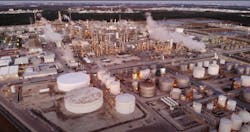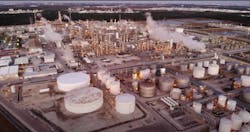Celanese Corp. offers a glimpse of what a digital chemical plant could look like. Remote, autonomous capabilities that remove workers from dangerous tasks and provide foresight into maintenance and quality issues.
“We want predictability. We want self-optimization, self-sustaining, self-adapting, self-learning and more automated activities where you can remove people from high-risk operations, and you can have access to data remotely,” explains Ibrahim Al-Syed, the company’s director of digital manufacturing.Celanese joins a growing number of chemical companies embarking on Industry 4.0 initiatives. It hasn’t always been that way for the industry. The chemical sector is historically slower than other industries when it comes to digitalization, as Darren Perry, managing director of L.E.K. Consulting, notes. But that’s primarily related to need rather than a lack of innovation. Other industries, such as automotive and building products, have more direct interaction with end customers, driving the need for more connectivity, Perry says.
“This doesn’t mean that there isn’t opportunity or, in fact, a burning platform for chemicals players to advance their digital strategies,” Perry says. “It’s just that other industries have been pushed to this point earlier.”
The drive to digital adoption is indeed changing quickly in the chemical industry. Chemical manufacturers logged a benchmark score of 65.6 out of 100 in the 2023 Nokia and ABI Research Industry 4.0 maturity index released on April 17. That’s on par with the average score for all industrial sectors.
Less than two years into its digital transformation, Celanese has begun scaling its plan across 30 of its 50 global sites. The $9.7 billion company partnered with industrial data software company Cognite to build a scalable data-modeling foundation.
A Balanced Approach to Digitalization
Companies must establish a long-term vision that aligns with the organization’s broader strategy before investing in digital technologies, Perry says.
“Without this underpinning and north star, companies find it very difficult to prioritize digital investments, [or] obtain buy-in across the organization,” he says.
Celanese emphasized a human-centric approach to its initiative, balancing the need for enabling technologies with access to data in a format that workers could use to become more efficient and effective at their jobs. This includes remote, autonomous capabilities.
Making this long-term goal a reality requires more than technology. Chemical operations must invest in the talent, Perry says. This often means hiring a chief digital officer and forming a cross-functional team that can look at opportunities across different functions and outside the organization, including the supply chain.
Technology Considerations
When it’s time to select a technology, a solid infrastructure and data strategy are critical. “Companies must engage in a realistic assessment of their technology and data platform and its ability to support the long-term digital vision,” Perry explains. “Oftentimes, this involves developing a single view of critical data assets and using new, often off-the-shelf analytics tools to extract insights.”Al-Syed already knew that adopting multiple technologies to solve individual operational issues would have created more problems.
“Once you start throwing 10, 20 different technologies out there, you are going to get a clunky architecture, and you are going to get a very poor user experience,” he says. “I have lived through that.”
The company sought the help of Cognite because the software provider offered a flexible platform that could integrate and contextualize data from multiple sources in real time, according to Al-Syed. The system also enables faster data search capabilities. It’s a type of “industrial Google” that can cut the time it takes to search for engineering documents from “a matter of hours to a matter of clicks,” Al-Syed says.
Robot Dogs and More
Looking ahead, a wide range of advanced digital technologies could become more common in chemical plants, such as generative artificial intelligence (AI). This type of AI can digest the knowledge or know-how in a plant and provide guidance on more effective solutions or help to augment workforce skills, says Eric Cosman, contributing consultant for ARC Advisory Group. Cosman also anticipates more innovation around technologies that enable energy management flexibility, the tracking of hazardous products in transit and the acceleration of research and development efforts.For Celanese, having a scalable, flexible model is the key to extending the wins already demonstrated during the proof-of-concept phase at its Clear Lake plant near Houston to 30 of the company’s legacy plants worldwide (Celanese acquired 20 additional plants in 2022 after purchasing DuPont's mobility and materials group). The company continues to experiment with other connected technologies that can bring further efficiencies, including the use of a “robot dog” from Boston Dynamics that may help operators save time by walking to far-off, hard-to-reach locations to perform gauge readings and reduce hazards for workers.
“The robot can also connect to 5G now, so technology has been changing very fast,” Al-Syed says. “The other use case we're looking at is for emergency response, which we haven't really tested yet.”
About the Author
Jonathan Katz
Executive Editor
Jonathan Katz, executive editor, brings nearly two decades of experience as a B2B journalist to Chemical Processing magazine. He has expertise on a wide range of industrial topics. Jon previously served as the managing editor for IndustryWeek magazine and, most recently, as a freelance writer specializing in content marketing for the manufacturing sector.
His knowledge areas include industrial safety, environmental compliance/sustainability, lean manufacturing/continuous improvement, Industry 4.0/automation and many other topics of interest to the Chemical Processing audience.
When he’s not working, Jon enjoys fishing, hiking and music, including a small but growing vinyl collection.
Jon resides in the Cleveland, Ohio, area.




